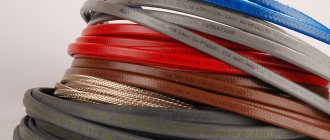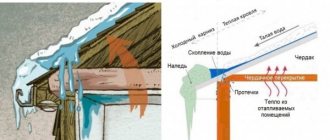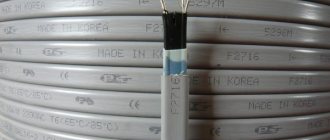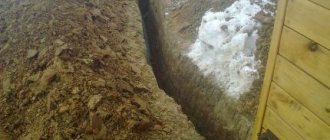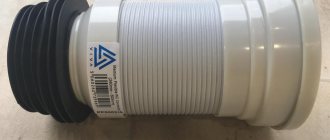When building a house without the help of specialists, not every owner takes into account climate changes throughout the year, so they forget to lay a heating cable for the water supply if it is installed above the freezing depth of the soil. To do this correctly, we will consider the types of wires, fastening methods, connection techniques and the procedure for thermal insulation. The article provides all this information, as well as a comparative analysis of cables, highlighting the advantages and disadvantages of each installation method.
Installation of cable along the pipe Source obustroeno.com
Features of the heating cable
The water supply cable is used to ensure that the water in the pipes remains in a liquid state even at subzero temperatures. In fact, it is a regular heating element that converts electrical energy into heat, taking into account the required temperature.
The design features that a heating cable for water supply must have are as follows:
- Multilayer , has several layers of insulation (according to GOST, at least 2).
- Increased flexibility . This allows installation of the cable on a pipeline of any configuration.
- Resistance to external influences and temperature changes.
- Immunity to aggressive conditions . Inside there should be a gasket in the form of a foil screen or copper braid. This avoids short circuits and neutralizes the magnetic field.
Internal filling of the cable Source koffkindom.ru
To choose the right heating cable, you should consider the main characteristics:
- Sufficient conductivity power for indoor installation per linear meter is 10 W/m.
- If the installation is carried out outdoors, then this figure should be increased to at least 20 W/m.
These nuances should be taken into account when choosing a wire in the same way as other indicators:
- Length . Not only the distance where the product will be laid is measured, but also the footage that will be required to insert the wires into the holes. A significant increase in length can lead to the fact that if the device is shorted or bent, the entire heating system will fail.
- Number of internal cores . Wires are produced in different thicknesses and have different conductor resistivities. The same diameter may differ in the internal filling, that is, in the number of cores.
Single-core and two-core cable Source sjevi.ru
- Section shape . Round – most often used for outer braiding. Flat - it is convenient to insert such a wire inside the pipe.
The maximum permissible temperature of the wire in the disconnected state should also be taken into account.
In which zone is it installed?
Any icing area must be equipped with a heating cable. Gutter gutters require a power of at least 300 W per square meter.
To heat drainpipes, install 2 pieces at the same time with a power of 20 W per square meter. meter.
Heating the valley roof will provide power in the range of 250-300 W per square meter. Installation is carried out at the top and bottom.
The roof eaves, made in the form of a “snake,” are heated by a cable laid along the very edge.
Table 1 (for metal pipelines).
Table 2 (for plastic pipelines).
Important:
- A cross marks areas where it is not recommended to wind the cable, as it can be damaged.
- The pipeline must be thermally insulated.
- The tables indicate the length that must be laid per 1 m of pipe. In cases where winding is required, the laying step in meters is given in parentheses.
- For those pipe diameters where flow rates are not indicated, it is necessary to use thermal insulation of greater thickness.
- The calculation of the lengths of the heating (heating) cable is valid for thermal insulation with a thermal conductivity of no more than 0.05 W/(m*K).
Types of cable
Before installation, it is important to study what heating wires are available and how to install them.
There are two types of cables: resistive and self-regulating.
The difference between them is that when an electric current passes through the cable, the resistive one heats up evenly along the entire length, while the feature of the self-regulating one is that the electrical resistance changes depending on the temperature. This means that the higher the temperature of the section of the self-regulating cable, the lower the current strength will be on it. That is, different parts of such a cable can each be heated to the desired temperature.
In addition, many cables are available with a temperature sensor and automatic control, which significantly saves energy during operation.
A self-regulating cable is more difficult to manufacture and costs more. Therefore, if there are no special operating conditions, then a resistive heating cable is often purchased.
Resistive
A resistive type heating cable for water supply has a budget price.
Cable differences Source teplina.rus
It is divided into several varieties, depending on the design features. Each of them has its own advantages and disadvantages:
| Cable type | pros | Minuses |
| Single-core | The design is simple. It has a heating metal core, copper shielding braid and internal insulation. On the outside there is protection in the form of an insulator. Heats up to a maximum of +65°C. | It is inconvenient for heating pipelines: both opposite ends, which are far from each other, must be connected to the current source. |
| Two-core | It has two cores, each of which is separately insulated. The additional third core is bare, but all three are covered by a foil screen. The external insulation has a heat-resistant effect. It heats up to a maximum of +65°C. | Despite the more modern design, it is not much different from a single-core element. The operating and heating characteristics are identical. |
| Zonal | There are independent heating sections. The two wires are insulated separately, and a heating coil is located on top. The connection is made through contact windows with conductive conductors. This allows heat to be created in parallel. | No shortcomings were found, if you do not take into account the price tag of the product. |
Resistive wires of different types Source yandex.net
Most buyers prefer to lay the wire “the old fashioned way” and purchase a wire with one or two cores.
Due to the fact that a cable with only two cores can be used to heat pipes, the single-core version of the resistive wire is not used. If the owner of the house unknowingly installed it, this threatens to short circuit the contacts. The fact is that one core needs to be looped, which is problematic when working with a heating cable.
If you install the heating cable on the pipe yourself, then experts advise choosing a zonal option for external installation. Despite the peculiarity of the design, its installation will not cause serious difficulties.
Additional features and advantages of zonal cables: stable power, you can cut the product and connect to the power source due to the presence of an end section. Another important nuance in single-core and double-core designs: on sale you can find already cut and insulated products, which eliminates the possibility of adjusting the cable to the optimal length. If the insulating layer is damaged, the wire will be useless, and if damage appears after installation, the entire system will need to be replaced. This disadvantage applies to all types of resistive products. Installation work of such wires is not convenient. It is also not possible to use them for laying inside the pipeline - the head of the temperature sensor gets in the way.
Wire design Source otdelkaexp.ru
See also: Catalog of companies that specialize in electrical engineering.
Another important nuance in single-core and double-core designs: on sale you can find already cut and insulated products, which eliminates the possibility of adjusting the cable to the optimal length. If the insulating layer is damaged, the wire will be useless, and if damage appears after installation, the entire system will need to be replaced. This disadvantage applies to all types of resistive products. Installation work of such wires is not convenient. It is also not possible to use them for laying inside the pipeline - the head of the temperature sensor gets in the way.
Self-regulating
Self-regulating heating cable for water supply with self-regulation has a more modern design, which affects the duration of operation and ease of installation.
The design provides:
- 2 copper cores in a thermoplastic matrix;
- 2 layers of internal insulating material;
- copper braid;
- external insulating element.
It is important that this wire works great without a thermostat. Self-regulating cables contain a polymer matrix. When turned on, carbon is activated, and when the temperature rises, the distance between its graphite components increases.
Self-regulating cable Source moydomik.net
On a note ! Self-regulating wire is more expensive, but these costs will pay off in the future. Pipes can be heated more intensely, using less electricity.
How the electrical cable works
The self-regulating cable is an electric heater in the form of a tape.
A cross-section of the heating cable consists of:
- metal heating conductor.
- conductors insulated with insulating PVC.
- internal insulation is made using fluoroplastic.
- screens made of copper mesh in which the conductors are located.
- The insulation on the outside consists of thermal insulation PVC material.
The insulating material resists the effects of water, is resistant to elevated temperatures, and is not affected by the harmful environment of wastewater. The materials have Sanpin approval for use in food water supply systems, so cables are allowed to be laid in cold water systems.
Reference! The cable has automatic control over the temperature level outside the pipe, therefore it is called self-regulating; it changes the heating level depending on the temperature regime.
The heating cable operates without human control. The system will automatically stop working if the ambient temperature exceeds the set values. Self-regulation protects the system from overheating, saving electricity consumption.
The advantages of a heating cable include:
Reliable and safe operation.- Simplicity of installation and operation.
- Energy savings due to automatic temperature control.
The main disadvantage is the cable's volatility. Some sections of the water supply must be equipped with additional sockets.
Installation methods
Installation work can be carried out in two main ways:
- When the wire is attached to the outside of the pipe.
- When - installed inside it.
Both methods have their own nuances. When choosing a cable laying method, you should also not forget about additional thermal insulation of the pipeline.
External cable installation
You can install the cable outside the pipe along it or around it using the ring (spiral) method.
Linear method
More often, wire installation is carried out linearly, when the cable for heating the water pipe is attached from below. Despite its simplicity, the method has its advantages, the main of which is protection. In this case, the risk of breaking the integrity of the wiring will be minimized, and the heating element will not suffer from mechanical damage from above. The electrical cable should be secured at the bottom. The fixation must be strong. Then the frost will not grab the water supply in case of a sharp drop in temperature.
Fastening along the pipe Source prom.st
On a note ! For fastening it is better to use: aluminum tape. It will increase heat transfer.
Ring method
The spiral method allows you to place the conductor along the outer radius of the pipe. This option is necessary for areas with low temperatures in winter. Due to the circular circulation, the water supply heats up better. The only downside of this method is that it requires a longer cable. To increase heating and properly secure the product, it is important to observe an intersection step no more than 5 cm.
On a note ! If there is a hard-to-reach area, then you can hug it with a small allowance. It is important to wrap the loops in the opposite direction.
Ring winding of heating cable Source www.dobroeteplo174.ru
Installation of individual components when laying cables outside the pipe
If you need to install the cable on separate metal supports, more material will be required to provide better thermal insulation. For this, only a self-regulating wire is used. Difficulty may arise from installing a temperature sensor, which will prevent the structure from overheating. It should be placed at the point where the heating rate is lowest. It is important to maintain the distance of the sensor from the cable line: no closer than a meter.
On a note ! The surface where the device will be installed is first glued with aluminum tape.
Is subsequent insulation of the heated pipeline necessary?
Another pressing question when organizing a pipe heating system is whether subsequent thermal insulation of the heated pipeline is necessary? If you do not want to heat the air and operate the cable at maximum power, then insulation is definitely necessary. The thickness of the insulating layer is selected depending on where the pipes are located and what minimum temperatures are typical for your region. On average, to insulate pipes located in the ground, insulation with a thickness of 20-30 mm is used. If the pipeline is above ground - at least 50 mm. It is very important to choose the “right” insulation , which will not lose its properties even after several years.
- It is not recommended to use mineral wool as an insulating material. They are not intended for use in conditions of high humidity, and when wet they instantly lose their properties. In addition, if wet cotton wool freezes, then when the temperature rises, it crumbles and turns into dust;
- Also, materials that can compress under the influence of gravity are not always suitable. This applies to foam rubber or polyethylene foam, which lose their properties when compressed. It is permissible to use such materials if the pipeline runs in a specially equipped sewer system, where nothing simply can put pressure on it;
- If pipes are laid in the ground, rigid thermal insulation “pipe in pipe” must be used. When another rigid pipe of larger diameter is put on top of the heated pipes and heating cable. For additional effect or in case of operation in harsh conditions, you can wrap the pipes with the same foamed polyethylene, and then cover the outer pipe;
- It is acceptable to use polystyrene foam, which consists of pipe fragments of different lengths and diameters. It has high thermal insulation properties, is not afraid of moisture and is able to withstand some loads, depending on the density. This type of insulation is often called a “shell”.
Connection and thermal insulation
The connection technique is universal, regardless of which wire is used, but there are nuances. The installation of the heating cable is completed by insulating the ends and connecting them to devices and sensors. To work you need to use the following equipment:
- knife;
- pliers;
- side cutter;
- construction hairdryer
First you need to prepare the cable. This will require additional terminals that come with the wire or pipe. Inside the sleeve has a special heat-shrinkable layer that improves the quality of the connection. Instead of a terminal, a special plug can be used. Only after this the end coupling is installed. To do this, first cut off a few centimeters of the outer insulation, then remove the braid, string the sleeve and heat it with a hair dryer so that shrinkage is successful. To be sure, the terminal should be clamped for a few seconds with pliers.
An example of cable installation inside a water supply system Source www.ingeneriya.ru
Manufacturer's choice
In order for the heating cable to serve you for more than one or two years and meet the declared parameters, you need to purchase products from trusted brands. Only in this case the costs of its purchase will be justified. The following manufacturers have earned trust:
- Thermo Industri AB is a Swedish manufacturer that is one of the largest in Europe. For quite a long time the company has been specializing in the production of cable heating systems. This narrow focus can ensure proper product quality and reliability. The production lines are represented by modern equipment. The use of modern technologies allows us to produce heating systems that are safe to use;
- Eltrace is a French manufacturer that adheres to two main criteria for finished products - quality and affordable cost. The company produces a self-regulating type of cable, which, depending on the application, includes two lines. Tubes-heat – for domestic and industrial pipelines. Traceco – for any type of heating systems;
- Thermon and Raychem are brands originating from the USA. The advantages of their products include safety and reliability, economical energy consumption, and convenient installation. It is worth noting that the self-regulating cable of these companies has an international quality control certificate;
- Devi is a manufacturer from Denmark whose products are of high quality. Initially, the company specialized in the production of heating elements for industrial needs. But already in the early 60s, one of the first heating systems based on electric cable was released. The company has extensive experience, which ensures high reliability of their products.
The article was written for the site.
Tags:Pipes
Nuances of installation work
When the wire is securely fastened inside or outside, it is important to take care of the insulation of the end of the conductor. Experts recommend using heat shrink tubing. This product will perfectly protect the conductors from moisture, which will reduce the risk of short circuits and repair work. We must not forget that the heating part must be connected to the “cold” part.
Connecting wires Source termodar-64.ru
Tips and recommendations from experienced craftsmen:
- If you use two methods of laying wires inside and outside the pipe at once, you can increase the rate of water heating several times, but this will require additional installation costs.
- Heating water pipes with a self-regulating heating cable will allow you to ignore warm sections and direct the current to cold places. It is allowed to be cut, so there will be no problems in installation even in hard-to-reach places. The cable length does not affect heat transfer.
- Resistive wire is half the price, but its service life is much shorter. If a regular two-core cable was installed, you should prepare for the fact that in 5-6 years it will have to be replaced.
- The braid on the wire serves to ground it. You can skip this stage of work, but it is better to become familiar with grounding methods.
What parameters influence the choice?
Before purchasing the required amount of cable, you need to clearly determine which type is suitable for your needs. The entire variety of this product differs according to five main characteristics:
- By type - the cable can be self-regulating or resistive. In this case, the operating principle of both heaters is the same. Heating occurs due to the current that flows through the internal conductors;
- Based on external insulation material . The possibility of application under certain conditions depends on this criterion. For example, to organize a sewer or drain heating system, it is necessary to choose polyolefin-coated cables. For cables that will be mounted on the roof or used for industrial purposes, where additional protection from ultraviolet rays is needed, there is fluoropolymer insulation. If the cable is laid in the internal cavity of water pipes, then it is better to choose food-grade coating, that is, fluoroplastic insulation. This will prevent the water from changing its taste, which sometimes occurs;
- Absence or presence of screen (braid). The braid makes the product stronger and more resistant to various mechanical influences; in addition, the screen serves as a grounding device. The absence of this element indicates that this is a product belonging to the budget category;
- According to the temperature class , there are low-, medium- and high-temperature heaters. This indicator is very important when arranging a heating system for water supply and drainage. Low-temperature elements heat up to a temperature of +65°C, their power does not exceed 15 W/m and are suitable for heating small-diameter pipes. Medium-temperature conductors heat up to a maximum of +120°C, the power reaches 10-33 W/m, they are used to prevent freezing of medium-diameter pipes or for heating the roof. High-temperature thermal cables can heat up to +190°C and have a power density of 15 to 95 W/m. This type is advisable to use for industrial purposes or in the presence of large diameter pipes. For domestic use, such conductors are considered too powerful and expensive;
- By power . The power characteristics of the coolant must be taken into account without fail. If you select a low-power conductor, you simply will not achieve the desired result. Exceeding the required value may lead to too high a level of energy consumption, which in practice will be unjustified. The choice of the required power level primarily depends on the diameter heated pipe. According to the recommendations of experts, for pipes with a diameter of 15-25 mm, a power of 10 W/m is sufficient, for a diameter of 25-40 mm - 16 W/m, for a pipe with a size of 60-80 mm - 30 W/m, for those exceeding 80 mm in diameter, – 40 W/m.
Video description
How to ground a water supply is shown in the video:
- Most often, for self-installation, a linear cable laying method is chosen.
- The level of heat transfer directly depends on what pipes are installed in the room. For plastic pipes, this figure will not be high, which means that when installing a heating cable for a water supply system, you will need to wrap the pipes with aluminum foil.
- Before attaching a cable to the outside of a metal pipe, it is important to ensure that there is no rust. If there is one, it requires cleaning and treatment with a special antiseptic. If this is neglected, there is a risk of damage to the insulation in the future.
- If fastening is carried out from the outside, then the distance between the insulating bundles should not be more than 30 cm. If you take a wider step, then after a while the fastening elements will separate.
- In practice, some craftsmen pull two wires at once to increase the heating rate. It is important that there is a small distance between the cables.
- For fastening to plastic, it is better to use special clamps.
Fastening with clamps and thermal insulation in section Source yandex.net
- If you decide to twist the wire in a spiral, then initially the pipe is wrapped with metallized tape.
- To fix the insulation, it is better to use special ties. They can be purchased at any hardware store.
- It is necessary to completely isolate the temperature sensor from the electrical cable to eliminate the risk of short circuit and fire. To do this, it is necessary not only to maintain a distance between these devices, but also to make the insulating gasket with a special material.
- Heating the pipelines with a heating cable using a thermostat will ensure constant temperature maintenance. It is better to install this device next to the electrical panel or directly in it. It would not be superfluous to install an RCD.
Wire with thermostat Source www.elektrikaup.ee
Criteria for choosing a cable
To install the cable into the water supply yourself, you need to choose the right product.
What criteria should you pay attention to:
- What is the purpose of the pipeline network? A cable intended to heat pipes transporting drinking water must be food-coated. Manufacturers indicate this feature in the instructions. This cable has a higher price than regular ones.
- Type of wire, required length of the product. Before purchasing a cable, install a warm-up section to determine the length of the cable. The type of cable and its operating principle also depends on the length.
The resistive cable cannot be cut to the required length. This cable has a lower price, but is more difficult to install and has a short service life.
The self-regulating heating cable can be cut into pieces and is supplied in a coil.
- The required cable power must be taken into account. The size of the communication system affects the power level of the wire. In order for it to cope with the task, it is necessary to select the electrical wire based on this parameter. As a rule, water supply system pipes are installed with a cross-section of 32 millimeters. For a given pipe size, electrical cables with a running meter power of 9 to 16 watts are used. In order to find out the power of the entire system, multiply the power per linear meter by the length of the section.
Important! Self-regulating cables are considered more advanced; experts recommend installing this type of electrical cable in water pipes. It is excellent for household piping.
- You should pay attention to the price of the cable. In this case, you cannot save on choice. If the cable is very cheap, you should check the service life of the cable: it may be expired or almost expired. At the end of its service life, the cable must be replaced, which will entail even greater expenses.
Reference! The quality of the internal matrix affects the price of the self-regulating cable, and at the same time increases the life of the system. Some cables can last up to 20 years, with a warranty period of up to three years. For example, xLayder-EHL cables from Caleo have these qualities.
- When choosing, you should pay attention to the manufacturer. The highest quality cables are considered to be German-made Eltherm Gmbh, American cables from Raychem, Heat Trace Products and LLC, Korean cables from Caleo, Eltrace from France, Devi from Denmark, and Finnish Ensto cables.
When purchasing, you should pay attention to the quality of the wires and seals. In this case, the shape of the internal section of the rubber band for sealing matters: round, square, rectangular. It must match the cable cross-section. Coupling connections must also be chosen of high quality; they should cost about the same as five meters of cable.

